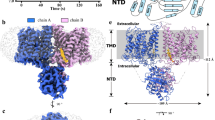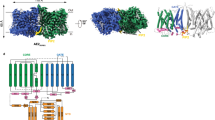Summary
The transport of inorganic anions across human red blood cell membranes is accomplished by a carrier-like mechanism which involves an electroneutral and obligatory one-for-one anion exchange. The transport kinetics were described by models that involve alternation of single transport sites between the two membrane surfaces. These models predict that each carrier shows either an inward-facingE i or an outward-facingE o, conformation, each capable of binding either a monovalent anion or a divalent anion+a proton, to yield an electroneutral translocating complex. Unidirectional transport rates provide, therefore, a measure for the relative concentration of carriers at a given membrane surface. In the present work we assessed how modulation of the transmembrane distribution of carriers by the anion composition of cells and media, and by pH, affect the anion transport system. We have set the system in asymmetric conditions with respect to anions, so that a fast transportable anion (e.g., chloride) was present in one side of the membrane and slow transportable anions (e.g., sulfate, phosphate, oxalate, isethionate, gluconate, HEPES) were present on the other side of the membrane. The skewed distribution of carriers induced in these conditions were assessed by two methods: 1) NBD-taurine transfer which provided a measure for [E i], the monovalent inward-facing form of the carrier, and 2) inhibition of NBD-taurine transfer by the specific impermeant and competitive inhibitor 4,4′-dinitro-2,2′-stilbene disulfonic acid (DNDS), which provided a measure for the availability of the carrier at the outer membrane surface. In the various symmetric and asymmetric conditions, we found marked differences in transport rates and transport profiles as well as in the susceptibility of the system to inhibition by DNDS. Direct binding studies of DNDS to cells in the various asymmetric conditions supported the conclusion derived from transport studies that transport sites can be recruited towards the membrane surface facing the slow transportable anions.
Similar content being viewed by others
References
Barzilay, M., Cabantchik, Z.I. 1979. Anion transport in red blood cells. II. Kinetics of reversible inhibition by nitroaromatic sulfonic acids.Membr. Biochem. 2:255–281
Barzilay, M., Cabantchik, Z.I. 1979. Anion transport in red blood cells. III. Sites and sidedness of inhibition by high affinity reversible binding probes.Membr. Biochem. 2:297–322
Brahm, J. 1977. Temperature-dependent changes of chloride transport kinetics in human red cells.J. Gen. Physiol. 70:283–306
Cabantchik, Z.I., Knauf, P.A., Rothstein, A. 1978. The anion transport system of the red blood cell: The role of membrane protein evaluated by the use of “probes”.Biochim. Biophys. Acta 515:239–302
Cleland, W.W. 1963. The kinetics of enzyme-catalyzed reactions with two or more substrates or products. I. Nomenclature and rate equations.Biochim. Biophys. Acta 67:104–137
Dalmark, M. 1975. Chloride transport in human red cells.J. Physiol. (London) 250:39–64
Dalmark, M. 1975. Chloride and water distribution in human red cells.J. Physiol. (London) 250:65–84
Eidelman, O., Cabantchik, Z.I. 1980. A method for measuring anion transfer across red cell membranes by continuous monitoring of fluorescence.Anal. Biochem. 106:335–341
Eidelman, O., Cabantchik, Z.I. 1983. The mechanism of anion transport across human red blood cell membranes as revealed with a fluorescent substrate. I. Kinetic properties of NBD-taurine transfer in symmetric conditions.J. Membrane Biol. 71:141–148
Eidelman, O., Zangvill, M., Razin, M., Ginsburg, H., Cabantchik, Z.I. 1981. The anion transfer system of erythrocyte membranes: NBD-taurine a fluorescent substrate analog of the system.Biochem. J. (Molecular Aspects)195:503–513
Gunn, R.B. 1972. A titratable carrier model for both mono- and di-valent anion transport in human red blood cells.In: Oxygen Affinity of Hemoglobin and Red Cell Acid-Base Status. M. Rorth and P. Astrup, editors. pp. 823–827, Munksgaard, Copenhagen
Gunn, R.B., Frohlich, O. 1979. Asymmetry in the mechanism for anion exchange in human red blood cell membranes: Evidence for reciprocating sites that react with one transported anion at a time.J. Gen. Physiol. 74:351–374
Jennings, M.L. 1978. Characteristics of CO2-independent pH equilibration in human red blood cells.J. Membrane Biol. 40:365–391
Jennings, M.L. 1980. Apparent “recruitment” of SO4 transport sites by the Cl gradient across the human erythrocyte membrane.In: Membrane Transport in Erythrocytes. U.V. Lassen, H.H. Ussing, and J.O. Wieth, editors. pp. 450–463, Munksgaard, Copenhagen
Knauf, P.A. 1979. Erythrocyte anion exchange and the band 3 protein: Transport kinetics and molecular structure.Curr. Top. Membr. Transp. 12:249–363
Knauf, P.A., Tarshis, T., Grinstein, S., Furuya, W. 1980. Spontaneous and induced asymmetry of the human erythrocyte anion exchange system by chemical probes.In: Membrane Transport in Erythrocytes. U.V. Lassen, H.H. Ussing, and J.O. Wieth, editors. pp. 389–403, Munksgaard, Copenhagen
Milanick, M.A., Gunn, R.B. 1982. Proton-sulfate cotransport: mechanism of H+ and sulfate addition to the chloride transporter of human red blood cells.J. Gen. Physiol. 79:87–113
Passow, H., Kampmann, L., Fasold, H., Jennings, M., Lepke, S. 1980. Mediation of anion transport across the red blood cell membrane by means of conformational changes of the band 3 protein.In: Membrane Transport in Erythrocytes. U.V. Lassen, H.H. Ussing, and J.O. Wieth, editors. pp. 345–372. Munksgaard, Copenhagen
Schnell, K.F. 1972. On the mechanism of inhibition of the sulfate transfer across the human erythrocyte membrane.Biochim. Biophys. Acta 282:265–276
Schnell, K.F., Gerhardt, S., Schöppe-Fredenburg, A. 1977. Kinetic characteristics of the sulfate self-exchange in human red blood cells and red blood cell ghosts.J. Membrane Biol. 30:319–350
Segel, I.H. 1975. Enzyme Kinetics: Behavior and Analysis of Rapid Equilibrium and Steady State Enzyme Systems. John Wiley & Sons, New York
Author information
Authors and Affiliations
Rights and permissions
About this article
Cite this article
Eidelman, O., Cabantchik, Z.I. The mechanism of anion transport across human red blood cell membranes as revealed with a fluorescent substrate: II. Kinetic properties of NBD-taurine transfer in asymmetric conditions. J. Membrain Biol. 71, 149–161 (1983). https://doi.org/10.1007/BF01870683
Received:
Revised:
Issue Date:
DOI: https://doi.org/10.1007/BF01870683




